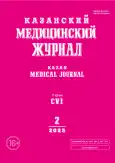A rare case of coexisting vascular anomalies and developmental variant of the brachiocephalic vessels
- Authors: Ayubov R.K.1, Yakovlev A.A.1, Dudarev M.V.1, Aidarova G.E.1
-
Affiliations:
- Izhevsk State Medical Academy
- Issue: Vol 106, No 2 (2025)
- Pages: 316-322
- Section: Clinical experiences
- Submitted: 26.07.2024
- Accepted: 17.12.2024
- Published: 21.03.2025
- URL: https://kazanmedjournal.ru/kazanmedj/article/view/634620
- DOI: https://doi.org/10.17816/KMJ634620
- ID: 634620
Cite item
Abstract
This article presents a rare case of coexisting vascular anomalies and developmental variants of the brachiocephalic vessels in a female patient who reported headaches triggered by food intake. The anomalies included: arteria lusoria, an aberrant right subclavian artery arising directly from the aortic arch and passing posterior to the esophagus; origin of the right vertebral artery from the right common carotid artery; origin of the left vertebral artery from the aortic arch; high vertebral artery entry points with hypoplasia; and excessive S-shaped tortuosity of the left internal carotid artery. This case is of particular interest due to the exceptional rarity of coexisting vascular anomalies and developmental variants in a single patient, qualifying it as a clinical curiosity. Variations in the origin and course of aortic arch branches may lead to altered cerebral hemodynamics and be associated with cerebrovascular disorders or neurological symptoms. Identifying atypical courses of the brachiocephalic vessels is crucial during preoperative assessment, as anomalous vascular anatomy may result in serious complications during surgical or endovascular interventions.
Full Text
About the authors
Roman K. Ayubov
Izhevsk State Medical Academy
Author for correspondence.
Email: ayubov.roman@gmail.com
ORCID iD: 0009-0000-1993-3124
SPIN-code: 2724-8400
student
Russian Federation, 2 Nizhnyaya st, IzhevskAleksey A. Yakovlev
Izhevsk State Medical Academy
Email: al-an.iakowlew@yandex.ru
ORCID iD: 0000-0002-1987-2138
SPIN-code: 1764-4447
PhD Stud., assist., Depart. of Histology, embryology and cytology
Russian Federation, 2 Nizhnyaya st, IzhevskMikhail V. Dudarev
Izhevsk State Medical Academy
Email: flatly@yandex.ru
ORCID iD: 0000-0003-2508-7141
SPIN-code: 4125-1073
MD, Dr. Sci. (Med.), Prof., Head of Depart., Depart. of the Polyclinic therapy with courses in clinical pharmacology and preventive medicine FPK and PP
Russian Federation, 2 Nizhnyaya st, IzhevskGulnara E. Aidarova
Izhevsk State Medical Academy
Email: gylnaraaydarova@icloud.com
ORCID iD: 0000-0001-8034-5073
SPIN-code: 4083-7310
student
Russian Federation, 2 Nizhnyaya st, IzhevskReferences
- Bae SB, Kang EJ, Choo KS, et al. Aortic Arch Variants and Anomalies: Embryology, Imaging Findings, and Clinical Considerations. J Cardiovasc Imaging. 2022;30(4):231–262. doi: 10.4250/jcvi.2022.0058
- Kachlík D, Varga I, Báča V, Musil V. Variant Anatomy and Its Terminology. Medicina. 2020;56(12):713. doi: 10.3390/medicina56120713
- Tasdemir R, Cihan OF. Multidetector computed tomography evaluation of origin, V2 segment variations and morphology of vertebral artery. Folia Morphol. 2023;82(2):274–281. doi: 10.5603/FM.a2022.0030
- Fomina YaV, Nikitina GV. Anomalies in the structure of vertebral arteries as a risk factor of cerebrovascular pathology. Morphologists. 2020;157(2–3):221. (In Russ.) EDN EMLZHH
- Inagi T, Sakai A, Ebisumoto K, et al. Recurrent Inferior Laryngeal Nerve Preservation During Thyroid Surgery in a Patient with Right Aortic Arch: A Case Report. Laryngoscope. 2024;134(4):1986–1988. doi: 10.1002/lary.31009
- Sarmiento JM, Cohen JD, Babadjouni RM, et al. Evaluation of tortuous vertebral arteries before cervical spine surgery: illustrative case. J Neurosurg Case Lessons. 2021;1(20):CASE2198. doi: 10.3171/CASE2198
- Murashov OV. Comprehensive analysis of the aortic arch branching patterns based on diagnostic studies, surgical procedures, and autopsy reports. Avicenna Bulletin. 2023;25(3):400–413. doi: 10.25005/2074-0581-2023-25-3-400-413
- Zakharova OE, Plakhova VV. Echocardiography for the solution of cardiac problems in newborns and infants with anomalies of the aortic arch and brachiocephalic vessels. Russian Journal of Thoracic and Cardiovascular Surgery. 2019;61(1):14–20. doi: 10.24022/0236-2791-2019-61-1-14-20
- Vihniakova MV, Larkov RN, Vihniakova MV. Computed tomography in the diagnosis of a rare anomaly of brachiocephalic arteries. Diagnostic radiology and radiotherapy. 2017;(3):33–36. doi: 10.22328/2079-5343-2017-3-33-36
- Yarikov AV, Smolin AA, Kazakova, LV, et al. Pathology of the Vertebral Arteries: Atherosclerosis, Pathological Deformity. Clinical Picture, Diagnosis and Treatment. Bulletin of Science and Practice. 2024;10(4):304–326. doi: 10.33619/2414-2948/101/35
- Gaibov AD, Nematzoda O, Kalmykov EL, Sharipov FK. Clinical and anatomical variants of the aortic arch: kinking and aneurysm of aortic arch. Case-report study of surgical treatment. Russian Journal of Operative Surgery and Clinical Anatomy. 2022;6(1):46–50. doi: 10.17116/operhirurg2022601146
- Ognerubov NA, Antipova TS. Aberrant right subclavian artery (аrteria lusoria): a case description. Tambov University Reports. Series: Natural and Technical Sciences. 2017;22(6):1473–1477. doi: 10.20310/1810-0198-2017-22-6-1473-1477
- Péč MJ, Kučeríková M, Grilusová K, et al. Arteria lusoria – a rare cause of dysphagia or a common accidental finding? Cor Vasa. 2021;63:612–614. doi: 10.33678/cor.2021.051
- Fanelli U, Iannarella R, Meoli A, et al. An Unusual Dysphagia for Solids in a 17-Year-Old Girl Due to a Lusoria Artery: A Case Report and Review of the Literature. Int J Environ Res Public Health. 2020;17(10):3581. doi: 10.3390/ijerph17103581
- Tudose RC, Rusu MC, Hostiuc S. The Vertebral Artery: A Systematic Review and a Meta-Analysis of the Current Literature. Diagnostics. 2023;13(12):2036. doi: 10.3390/diagnostics13122036
- Elnaggar ME, Abduljawad H, Assiri A, Ebrahim WH. Anomalous origin of right vertebral artery from right common carotid artery. Radiol Case Rep. 2021;16(6):1574–1579. doi: 10.1016/j.radcr.2021.03.059
- Tokuyama K, Kiyosue H, Baba H, Asayama Y. Anomalous Origin of the Right Vertebral Artery. Applied Sciences. 2021;11(17):8171. doi: 10.3390/app11178171
- Moran J, Kahan JB, Schneble CA, et al. High-Entry Vertebral Artery Variant during Anterior Cervical Discectomy and Fusion. Case Rep Orthop. 2021;2021:1–6. doi: 10.1155/2021/8105298
- Bakalarz M, Rożniecki JJ, Stasiołek M. Clinical Characteristics of Patients with Vertebral Artery Hypoplasia. Int J Environ Res Public Health. 2022;19(15):9317. doi: 10.3390/ijerph19159317
- Dinç Y, Özpar R, Emir B, et al. Vertebral artery hypoplasia as an independent risk factor of posterior circulation atherosclerosis and ischemic stroke. Medicine. 2021;100(38):e27280. doi: 10.1097/MD.0000000000027280
- Dean CJ, Labagnara K, Lee AK, et al. Bilateral vertebral arteries entering the C4 foramen transversarium with the left vertebral artery originating from the aortic arch. Folia Morphol. 2023;82(3):721–725. doi: 10.5603/FM.a2022.0059
- Welby JP, Kim ST, Carr CM, et al. Carotid Artery Tortuosity Is Associated with Connective Tissue Diseases. AJNR Am J Neuroradiol. 2019;40(10):1738–1743. doi: 10.3174/ajnr.A6218
- Gavrilenko AV, Abramyan AV, Kuklin AV, Ofosu D. Internal carotid artery kinking. The clinic, diagnosis and surgical treatment. Russian Journal of Cardiology and Cardiovascular Surgery. 2016;9(1):29–33. doi: 10.17116/kardio20169129-33
Supplementary files









